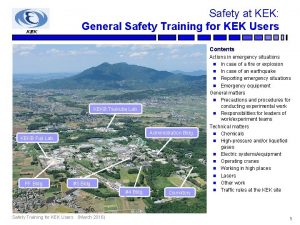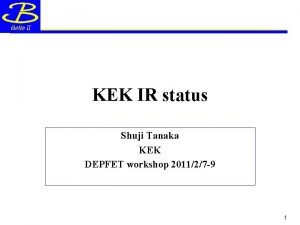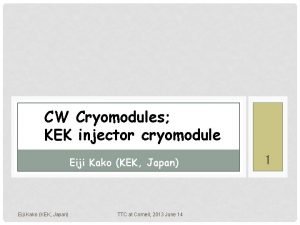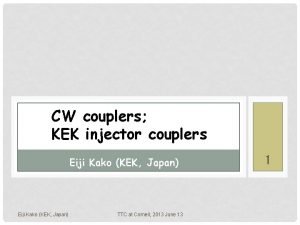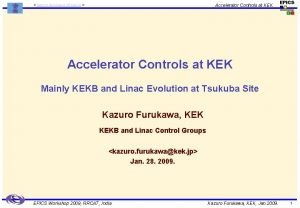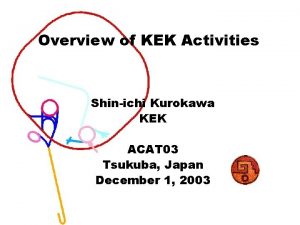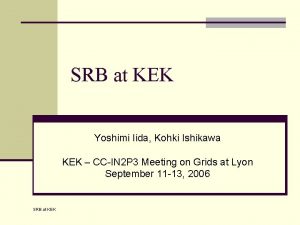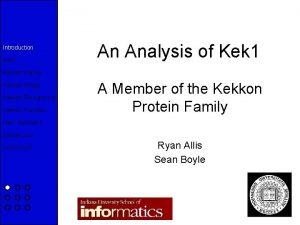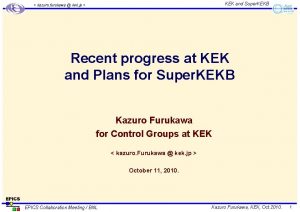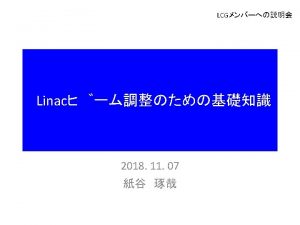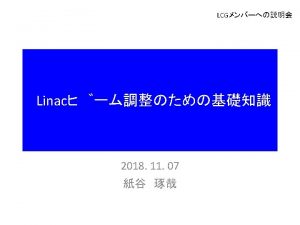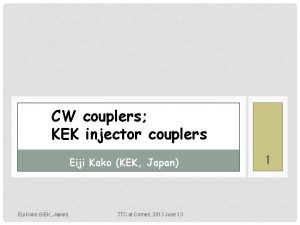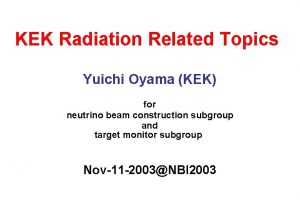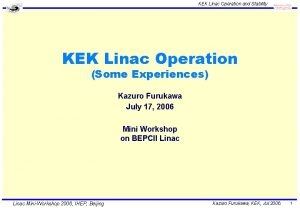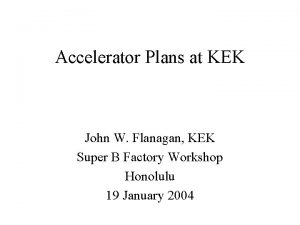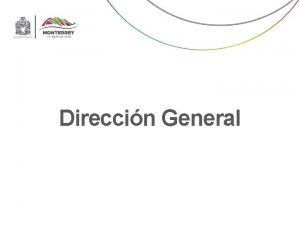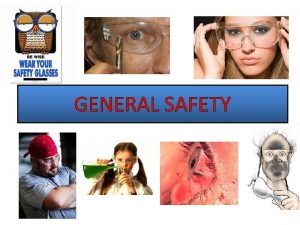KEK Safety at KEK General Safety Training for
























- Slides: 24

KEK Safety at KEK: General Safety Training for KEK Users Contents KEKB Tsukuba Lab. Administration Bldg. KEKB Fuji Lab. PF Bldg. #3 Bldg. #4 Bldg. Safety Training for KEK Users (March 2016) Dormitory Actions in emergency situations n In case of a fire or explosion n In case of an earthquake n Reporting emergency situations n Emergency equipment General matters n Precautions and procedures for conducting experimental work n Responsibilities for leaders of work/experiment teams Technical matters n Chemicals n High-pressure and/or liquefied gases n Electric systems/equipment n Operating cranes n Working in high places n Lasers n Other work n Traffic rules at the KEK site 1

KEK n n In Case of Fire or Explosion: First Action Alert people in the area who may not be aware of the incident. Activate the fire alarm. Report the incident to your team leaders and the KEK Information Center (ext. 3399). If you can assist: – – – Get help first. Do not fight the fire alone. Do not underestimate threat of the incident. Always make human life and safety the first priority. Prevent a second incident. Provide any requested information to staff members or firefighters and follow their instructions. Safety Training for KEK Users (March 2016) 2

KEK n In Case of an Earthquake: First Actions If an earthquake occurs: – Protect yourself: take appropriate shelter (e. g. , get under a sturdy desk) until the shaking stops. n After the earthquake: – When it is safe to do so, evacuate to the predetermined emergency assembly area. – Do not leave the area until a roll call is conducted by your work or experiment team leader. – If you find a injured person, call ext. 3399. – Follow all directions from your team leader or KEK staff members. n Do not resume operating any experimental equipment until an inspection has been completed by KEK staff members. Safety Training for KEK Users (March 2016) 3

KEK n n Reporting Emergency Situations If an accident or incident occurs, inform KEK Japan staff first. If you are in Tsukuba Hall, contact the Front Desk (ext. 3510). For detailed procedures and emergency contact numbers, refer to booklet or leaflet (shown here). They are posted in several areas around the KEK campus. You can also find information at KEK HP: https: //stw. kek. jp/stpg/hso/kinkyu Safety Training for KEK Users (March 2016) 4

KEK Emergency Equipment: Fire Extinguishers・AEDs・Stretchers Examples of dry powder and liquid fire extinguishers. Carbon dioxide fire extinguisher. Caution: Handle with care to avoid depleting oxygen levels, which can cause suffocation. Safety Training for KEK Users (March 2016) Automated external defibrillators (AEDs) are located at the Front Desk in Tsukuba Hall. (Normal) (Wheelchair) Stretchers are available in the Health and Safety Office. 5

KEK n n n Before Starting Experiments Clarify the your experimental team’s contact procedure in case of emergency Appoint a leader for your work or experiment team. ※ Confirm the following: – – Emergency procedures and contacts Nearest assembly area Escape routes and emergency exits Location of fire extinguishers, fire hydrants, flashlights, and first-aid kits – How to use fire extinguishers and hydrants. n Before starting experiments, have a meeting to confirm a work plan for safety. ※ University, laboratory, or company staff person who can direct work on site. The leader will act as a liaison with KEK staff. Safety Training for KEK Users (March 2016) 6

KEK n Safety Precautions for Experiments: Part Ⅰ Do not put anything near machinery, electrical distribution boards, doorways (emergency exits), aisles or safety equipment that would impede access. – Keep safety equipment, such as fire extinguishers or flashlights, accessible. n When stacking objects, assure they are positioned to avoid toppling over. – Do not place tall objects or stack items that may be at risk of falling in the evacuation routes. – Take extra precautions against items that may fall in the event of an earthquake. n Lock gas cylinder casters or use wheel blocks for safety. Safety Training for KEK Users (March 2016) 7

KEK n n n Safety Precautions for Experiments: Part ⅠI If you determine there is a workplace hazard, notify your team leader/contact person. Keep everything in order within your work area. Walk in safety aisles. Follow KEK staff’s directions. Always work with more than one person inside an enclosed space and in known hazardous areas. Wear appropriate work clothing: helmets, safety boots, safety belts, protective glasses, earplugs, and/or gas masks. – Sandals are not allowed in Tsukuba or Fuji Hall B 4 areas. – Short pants are not recommended. Safety Training for KEK Users (March 2016) 8

KEK n Warning Lights and Signs for Radiation. Controlled Areas When a warning light is on or flashing, stay away from the device and/or the area. High Voltage/Intense Magnetic Field (Red) n The following sign is posted near the entrance to a radiationcontrolled area. Do not enter without permission. Radiation-controlled area Radiation (Yellow) High-pressure Gas (Green) Safety Training for KEK Users (March 2016) Note: Intensive training for Radiation Safety at KEK is conducted separately. 9

KEK n n When Suspending Experiments Take appropriate measures to ensure the safety of any in-use devices and tools, especially watch out for fire hazards. If any safeguards (safety fences, etc. ) are temporarily disengaged for your work/experiment, restore them to normal operation upon completion. When you suspend experiments during nights, weekends, or holidays, post a notice. If you require electricity during nights, weekends, or holidays, ask KEK staff or your team leader/ contact person in advance. Safety Training for KEK Users (March 2016) 10

KEK n n n Work/Experiment Team Leader Roles: Part I Provide safety guidance to workers (e. g. , students and coworkers) related to the work/experiments. Clarify the work plan and ensure safety procedures before starting any work/experiments. Have a meeting to confirm the work/experiment plan, procedures, and environment with your work/experimental team members. Exchange information related to your experiment with workers and KEK staff. When you begin, suspend, and complete work/experiments, confirm the situation is safe and report the current condition to the safety shift or your KEK contact person. Safety Training for KEK Users (March 2016) 11

KEK n n n Work/Experiment Team Leader Roles: Part II Monitor your work/experiment area regularly during work/experiments. If a hazard is discovered, take appropriate action to ensure safety (e. g. , installation of safety fences or protective covers). Instruct team members to wear protective equipment appropriately. In case of earthquake or emergency, take a roll call and report the result to a shift worker or your host staff member. In case of earthquake or emergency, confirm the location and condition of team members, including those staying in a residential facility (e. g. , dormitory). Report the result to a shift worker or your contact person at KEK. Safety Training for KEK Users (March 2016) 12

KEK n n n n Using Chemicals: Precautions Approval is required to purchase or bring chemicals into the KEK facility. Before acquiring any chemicals, you should submit a “Request for Getting Chemicals” form to the Chemical Safety Control Office (ext. 5498). ※ Prepare the Material Safety Data Sheet, “MSDS. ” Label for Chemicals Label the chemical container to clarify the owner. For storing and/or using chemicals, follow directions from a chemical cabinet manager. Use all chemicals in the appropriate designated area. Waste liquid or empty bottles should not be disposed of in a sink or dust bin. Bring waste chemicals to the Chemical Safety Control Office for proper disposal. If you have questions, ask your contact person or a chemical cabinet manager. ※ Approval also is required for toxic metals (e. g. , lead Safety Training for KEK Users (March 2016) cadmium, mercury, selenium) and their compounds. 13

KEK n Store cylinders vertically at a pre-assigned place using clamps. – n n n n n Handling High-Pressure or Liquefied Gas Cylinders: Precautions Clamps can prevent cylinders from falling over in the event of an earthquake. Use a suitable reducing valve. Never put fire or heat source close to cylinders. Never connect electric wiring with cylinders and clamps. Shut a main valve and let pressure out of a reducing valve after use. If there is any problem, stop using the gas immediately and contact a KEK staff member. Put the label with a cylinder’s information (e. g. , “full-充” or “empty-空”) along with the name of the gas and user’s name on the cylinder. Use a dedicated carrier for moving any gas cylinders. When moving cylinders with a crane, use a basket or a bag, not a magnet or a wire. Do not impact a cylinder. When not in use, replace the cover on a cylinder. Safety Training for KEK Users (March 2016) 14

KEK n Handling High-Pressure or Liquefied Gas: Precautions Use extreme caution to prevent: – Burst of a cryogenic container due to pressure increases by vaporization. – Blockage of pipe/valve with freezing moisture. – Frostbite due to ultra-low temperature. – Suffocation due to shortage of oxygen or inhalation of low-temperature gas. n n Install pressure gauges on cryogenic containers. Wear proper protective equipment (e. g. , leather gloves). Safety Training for KEK Users (March 2016) 15

KEK n High-Pressure Gas Facilities When dealing with high-pressure gas manufacturing and refrigeration facilities: – Do not enter the facility area without permission from authorized facility officers. – If you find a problem or malfunction, contact the responsible facility officers. – Whenever an incident occurs, follow instructions provided by the responsible facility officers. n For inquiries about high-pressure gas facilities, consult your contact person at KEK. Safety Training for KEK Users (March 2016) 16

KEK n n Operating Low-Voltage Electrical Equipment: Precautions Pay special attention to prevent an electric shock or electrical fire. Pay special attention to work near charging stations and equipment. Using electricity distribution boards requires specific permission from electrical system officers. A red warning light must be engaged during operation of high-current equipment/instruments. – Magnetic excitation is especially dangerous. n Important to Note: – Low-voltage: under 600 V (alternating current) and under 750 V (direct current) – Consult responsible officers on electrical specifications for work/experiments using high-voltage electricity. Safety Training for KEK Users (March 2016) 17

KEK n n n n Maintaining Low-Voltage Electrical Equipment: Precautions Do not put too many plugs in one outlet. Use an unwound cable from a cable reel. Do not leave electrical wiring on the ground. Maintain your experiment equipment in normal operating condition. Do not use defective/damaged equipment. Try to switch breakers on or off only when there is no electrical load on the circuit. Cancel the remote operation function to check electrical equipment. Refrain from wearing metal while working with electrical equipment. Safety Training for KEK Users (March 2016) 18

KEK n n n Crane Operation: Precautions A Japanese license and appropriate qualifications are required to operate cranes. To arrange for crane operation, consult with your contact person at KEK. When cranes are in operation, remain out of the way of the work and never stand under the loads. Safety Training for KEK Users (March 2016) 19

KEK n n n n Working in High Places (>2 m): Precautions Wear a helmet and appropriate shoes. Wear the proper safety belt or harness (provided at Tsukuba Hall B 4 at the elevator). When using ladders, never stand on the top step. In case footholds or catch fences are not provided, ask your KEK contact person to install them before proceeding with any work. Be careful not to drop tools during high-place work. High-place work at night or in darkness is highly discouraged. Seek assistance from your KEK contact person to acquire the proper lighting. Do not conduct work in high places during inclement weather conditions (e. g. , strong wind; heavy rain or snowfall). Safety Training for KEK Users (March 2016) 20

KEK n Laser Operations: Precautions Prior to using a laser for your experiment, consult your KEK contact person. – Also read the “Manual for Laser Equipment” carefully and follow the instructions. n n n Only authorized persons are allowed to enter laser-controlled areas. To operate a laser or enter laser-controlled areas, safety training by a laser operation manager is required. Do not bring reflective items (e. g. , watch or mirror) into laser-controlled areas. When a laser is in operation, a warning sign should be posted. Do not set up a laser beam path at eye level or look directly into the laser when the main switch is on. Wear protection glasses suitable for the specific laser wavelength. Safety Training for KEK Users (March 2016) 21

KEK n Additional Precautions for Experiments If the following work is necessary for your experiment, consult your KEK contact person: – Work causing fire or smoke, such as welding, burner operation, or grinder and soldering iron – Work in place with a potential risk of oxygen-deficiency, for example, a pit, tank, or other sealed places (a tunnel) – Handling experimental cooling water – Work at the machine shop – Work requiring a roadblock (for more than 30 minutes). Safety Training for KEK Users (March 2016) 22

Local Traffic Rules at the KEK Site KEK n Essentially, local traffic rules at KEK follow Japan’s Road Traffic Laws: – – n n Yield to pedestrians in crosswalks. The speed limit is 30 km/h. Do not park in the road, sidewalks, lawns, etc. A vehicle permission pass should always be visible and placed in the vehicle’s front window. Always carry your identification card (with photo) for security checks at KEK’s main gate. When you ride a bicycle on the Tsukuba campus: – Yield to pedestrians – Turn on the bicycle headlight after dark. Safety Training for KEK Users (March 2016) 23

KEK Contacts: Belle II Safety Shift (Ext. 2418) Safety Team at IPNS (Ext. 4158, 4490) Health and Safety Office (Ext. 5119) Safety Training for KEK Users (March 2016) 24
 Dr csiki vanda
Dr csiki vanda Safety care certification
Safety care certification Kontinuitetshantering i praktiken
Kontinuitetshantering i praktiken Typiska drag för en novell
Typiska drag för en novell Nationell inriktning för artificiell intelligens
Nationell inriktning för artificiell intelligens Ekologiskt fotavtryck
Ekologiskt fotavtryck Shingelfrisyren
Shingelfrisyren En lathund för arbete med kontinuitetshantering
En lathund för arbete med kontinuitetshantering Särskild löneskatt för pensionskostnader
Särskild löneskatt för pensionskostnader Tidbok
Tidbok A gastrica
A gastrica Vad är densitet
Vad är densitet Datorkunskap för nybörjare
Datorkunskap för nybörjare Boverket ka
Boverket ka Debattartikel struktur
Debattartikel struktur Autokratiskt ledarskap
Autokratiskt ledarskap Nyckelkompetenser för livslångt lärande
Nyckelkompetenser för livslångt lärande Påbyggnader för flakfordon
Påbyggnader för flakfordon Tryck formel
Tryck formel Offentlig förvaltning
Offentlig förvaltning Kyssande vind
Kyssande vind Presentera för publik crossboss
Presentera för publik crossboss Jiddisch
Jiddisch Vem räknas som jude
Vem räknas som jude Treserva lathund
Treserva lathund

























